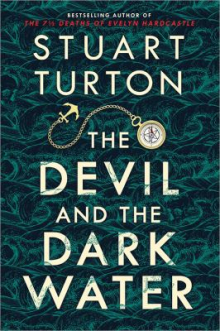
In a "locked-room" or "impossible crime" mystery, a crime, or series of crimes, is committed under circumstances that appear, at least initially, impossible for said crime to have been enacted. Those same conditions will also seem to preclude the criminal entering or exiting the crime scene.
The first “locked-room” mystery was Edgar Allan Poe’s “The Murders in the Rue Morgue” published in 1841. Other classics of the subgenre are Gaston Leroux’s The Mystery of the Yellow Room; “The Speckled Band,” a Sherlock Holmes adventure by Sir Arthur Conan Doyle; and Agatha Christie’s And Then There Were None. Now Stuart Turton has a new mysterious puzzle to be solved, this time on a 17th century sailing ship.
The year is 1634. The location is Batavia, the capital of the Dutch East Indies, what we would now refer to as Jakarta, Indonesia. A procession makes its way through the city and down to the docks, where a fleet of Indiaman sailing ships, including the Saardam, will be making their way back to Amsterdam. As the procession moves toward the docks, a leper curses the Saardam, and all who sail upon her, in the name of his master “Old Tom ... the lord of hidden things, all desperate and dark things”, and that all who board her will be brought to “merciless ruin.” He then bursts into flames and dies on the docks. Among those who witness his death are Governor General Jan Haan, his wife Sara Wessel, Problematary Samuel Pipps, and his bodyguard and partner, Arent Hayes. Pipps is under arrest, although no one knows the crime of which he is accused, and he is locked away in a cell immediately after arriving on board.
Shortly after the Saardam leaves the dock, strange occurrences begin to happen. A strange symbol attributed to Old Tom is seen on the main sail when it is unfurled. The leper that cursed the ship, and died immediately afterward, is seen on the ship. And everyone on board begins to hear strange whispers in the night alternately promising the listener their wildest dreams granted, or threatening that they will die in equally unpleasant manners. With Pipps incarcerated, Arent must find out how and why these things are happening on the ship. Joined in his search by Sara Wessel, the two must unravel the knots of this mystery or face the fact that the Saardam, and all aboard, may be lost.
In this novel, Stuart Turton, author of 2018’s excellent The 7 ½ Deaths of Evelyn Hardcastle, presents readers with a decidedly different, and yet equally challenging, mystery to solve. The characters are marvelously complex and encompass almost every type of passenger aboard the Saardam, including nobles, passengers, crew, the Musketeers assigned to protect the investment represented by the East India Trading Company on the voyage.
Turton also does a wonderful job conveying the period in which the novel is set, the 17th century, and also the location upon which most of the tale takes place: a sailing ship. Turton describes all of the different decks and levels, how they are connected and accessed (or not). While travelling via sailing ship has been romanticized over the centuries, Turton describes how the travelling conditions on such a ship must have truly been: claustrophobic, dark, dank, filled with unpleasant smells, sights, and experiences. These conditions affected everyone on board, regardless of their social status or wealth.
The mystery presented is engrossing. It incorporates superstition, hidden identities, political and societal brinksmanship, and, lusts of all kinds, including riches, power, and revenge, and will keep readers guessing until the very last page.
Be sure to read the author's interview.